Architecture and engineering teams have a common goal, which is to ensure productivity and growth.
It is a vital aspect of their interests given the nature of tasks and activities carried out in the industry.
Architecture requires an enormous but necessarily high precision level, complete legal compliance, as well as strict adherence to deadlines.
Hence architecture project management software becomes an invaluable asset for the respective individuals in the field.
The purpose of which would be to enhance employee productivity, among other things.
Consider the most notable projects in modern history, which are architectural- the likes of the Petronas Twin Towers, One World Trade Center, and Burj Khalifa.
Imagine the amount of planning, collaboration, and execution that contributed to the success of the projects.
As we have in other fields, architecture, and engineering have witnessed an incredible revolution in the last decades.
This was possible because of the extent of innovations happening in recent years.
Talk about Building Information Modeling (BIM) and the Internet of Things (IoT), new technology has been infused into the field more recently.
The goal is to provide a means of handling mundane tasks more efficiently. What’s more?
The new technology has brought about better ways of crafting complicated designs- and ultimately, simplifying complex or seemingly impossible projects.
Owing to this new infusion and introduction of technology, project management software finds great usefulness in the world of architecture.
In other words, there are a vast number of novel project management software or tools which are bringing about newer and faster ways for architects and engineers to operate.
These professionals can, therefore, find help in these tools to save time, optimize workflows, and ensure better deliverables to clients.
- Project Management Software For Complex Projects
- Project Management Software With Email Integration
- Free Project Management Software for Real Estate Development
- Project Management Software for Multiple Company Departments
- Project Management Software for Landscapers
- Project Management Software For Small Business
- Project Management Software for Startups
- Project Management Software For Nonprofits
- Project Management Software For a Painting Company
- Project Management Software For Craftsmans
- Project Management Software for Freelancers
- Project Management Software for Multiple Projects
- Project Management Software For Outsourcing
- Project Management Software For Daily Activities
- Free Project Management Software
- ClickUp Vs. Trello
- Monday.com Vs. Trello
- ClickUp vs Confluence
- Monday.com Vs. Float
- ClickUp Vs. Todoist
- Monday.com vs Asana
- Clickup vs Notion
- ClickUp vs Smartsheet
- Monday.com vs Airtable
- ClickUp vs Bitrix24
- Monday.com VS Github
- Monday.com vs Sharepoint
- Clickup vs Teamwork
- Monday.com vs. Meistertask
- ClickUp vs. Airtable
- What Is Project Management Software?
- What Are Some Unique Features of Project Management Software?
- Is it Difficult to Use a Project Management Software Well?
- What to Look for in Project Management Software?
- What is “Portfolio” inProject Management Software?
- How To Use Project Management Software?
- How Much Does Project Management Tools Cost?
- Who Invented Project Management Software?
- Why Use Project Management Software?
- What Is The Most PopularProject Management Software?
- How Much Does Project Management Software Increase Productivity?
- What is The Purpose of Project Management Software?
- What Is FreshWorks & What Does It Do?
- What Does Workflow Management Software Do?
- Can Asana Be Used For Personal Use?
Why use Project Management Software for Architects?
Architects usually work with groups of professionals, including stakeholders, contractors, engineers, and clients.
Project management software can help team members communicate and collaborate more effectively, minimizing the chance of misunderstanding.
Architects can work more productively and safely by streamlining their workflow with the aid of project management software.
Task lists, time frames, and reminders are among features that can help keep individuals on track and make sure that the projects are finished on time and under budget.
Project management software may create statistics and analytics that can assist architects in identifying patterns, trends, and areas for improvement.
Having access to this knowledge would enable architects to make wiser decisions and perform better overall.
What makes good Project Management Software for Architects?
Data security and accessibility should be prioritized in good project management software for architects.
Architects work with sensitive project information, thus the software should guarantee that data is protected and frequently backed up to avoid loss or unauthorized access.
The software must also be usable on a multiple platforms and at various places so that team members can communicate anytime, anywhere.
The program should also have an easy-to-use interface and be easy to learn and utilize.
This makes it possible for team members to become proficient with the software fast and give more attention to project-related duties than to learning how to use it.
How to choose the right Project Management Software for Architects
While choosing project management software for architects, it is important to consider cost and budget.
Although some software options can cost more than others, they could include features that are more in line with project requirements.
Evaluate the software’s long-term return on investment (ROI) and compare the advantages against the expense.
The project team must be included in the decision-making process as well.
Consult team members to learn what tools and functionalities they need to effectively complete their tasks.
This ensures that the software fits the requirements of the whole team and is easy to implement and integrate into project activities.
Another thing to assess is the repute and track record of the software provider.
Look for reviews, ratings, and comments from new or existing users to establish the quality of the program and the provider’s level of customer support.
Best Project Management Software for Architects
The main interest of this article is to highlight how architecture project management can take advantage of employing the appropriate suite of project management software.
Architectural projects, like many others, need easy communication among the stakeholders.
Budgeting and financial planning are also critical aspects of the project.
All these can be successfully achieved using the right tool.
1. Wrike
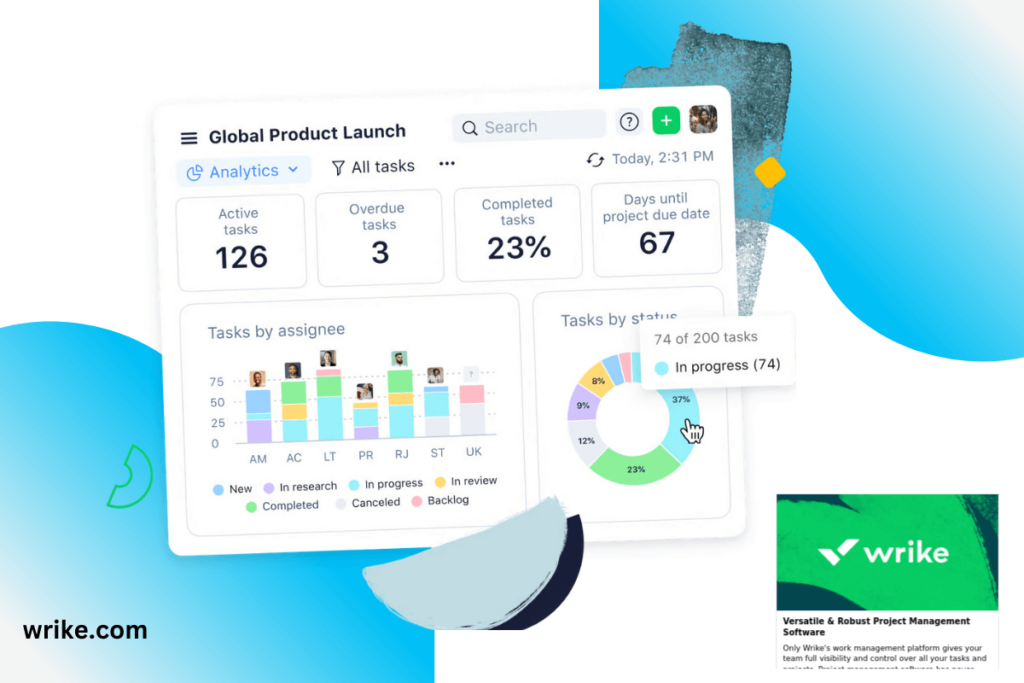
Wirke can help users set up custom dashboards for their team members to view tasks, activities, and more.
It is best for mid-size and enterprise organizations, and also particularly suitable for architectural firms.
Wrike is a collaborative work management tool designed for creatives and professionals for planning, managing, and completing work at scale.
Some of its project management features are custom workflows, custom dashboards, process streamlining, and collaboration features including document management, version control, and discussion boards.
It also has a time-tracking tool, but cannot execute billing and invoicing.
2. Bonsai

Running an architecture business is never easy because you have many projects to tackle at any given time. If you don’t have the staff for it, then you might be piling on more work than you can take. If that is the case with you, then you need to opt for Bonsai as your partner in the architecture business.
You can focus on how to wow your clients, while Bonsai will take care of tedious tasks that can easily be automated. Take advantage of the proposals feature to create some of the best proposals for your clients that will help you land more business. On the other hand, you use the invoicing feature to set your rates, so there is no confusion between you and your clients.
The best part is that if you have a huge team, then Bonsai will help everyone on the team work together on a certain project or task. The team working on the project can work with one another by sharing notes, getting reminders for deadlines, and more. All of these features are there so that the team can effectively communicate and work on a project with the least hiccups.
So, if you want a project management tool for your architecture business that grows with you, then you can begin your journey with Bonsai. It is affordable, and you will put your budget to good use by opting for this tool. As you do, Bonsai will offer a high return on investment.
3. Hubstaff
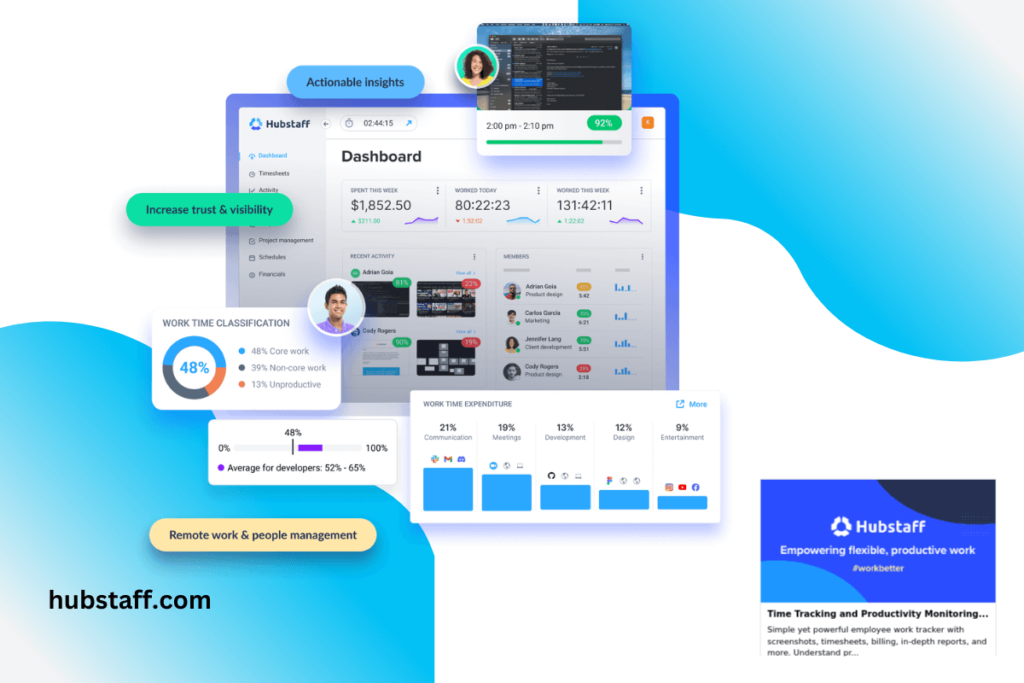
Hubstaff is particularly suitable for time tracking and managing productivity.
With Hubstaff, architects and engineers can keep track of their projects, while team members can also monitor their working hours from any device- whether they are on or off a job site.
It features a project timesheet where these respective data go into.
Users can also manage payroll and invoicing from the dashboard.
At the same time, it offers a great means of analyzing and concluding based on the reports provided by the tool.
After the project, the project manager or architect can use the task and time data to conduct an estimation of future jobs to ensure profitability for the company.
Also, the tool can be used with a special feature, “Hubstaff Tasks” to manage projects and time appropriately.
Hubstaff also assists in creating checklists, customizing workflows, and keeping time and tasks in sync, all of which are necessary for tracking time and projects effortlessly.
4. Archisnapper
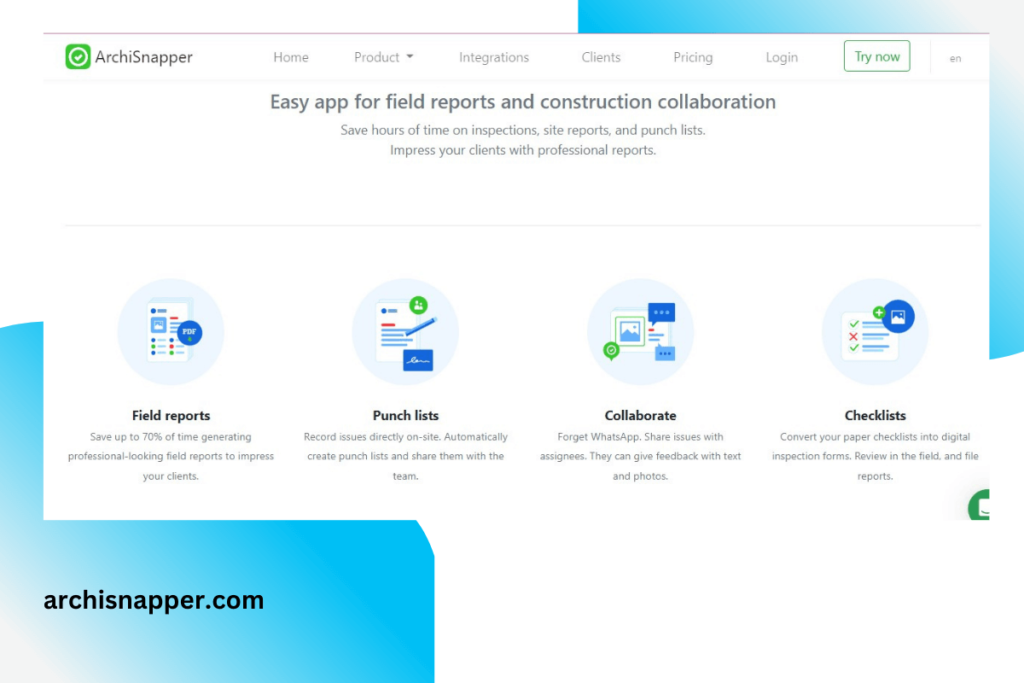
Archisnapper is a project management tool used by architects to conduct field reports, punch lists, and safety reports.
Specifically designed to help architects and engineers transcend the traditional means of observing and recording on-site data, ArchiSnapper assists in sketching lines, marking up blueprints, photographing, and generating and distributing reports.
It has a way of organizing and classifying, and uploading data in the cloud such that team members have access from different locations and on any kind of device.
5. CMAP
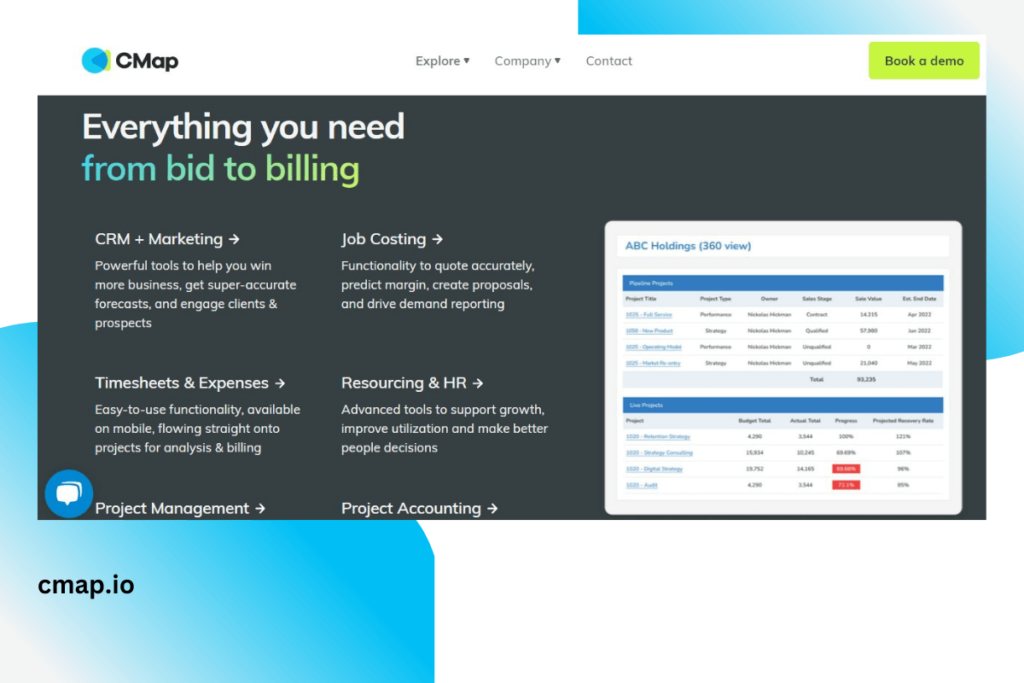
CMAP is a unique management tool that also doubles as accounting software to manage project-based businesses.
An edition of the software is tailored to meet the needs of architects and engineers, particularly to assist with job costing and for easy project planning.
The platform provides managers with a means of tracking project performance with time live sheets, purchase invoices, and expenses.
With the tool, managers can handle resource planning more effectively and organize the workload schedule of their teams efficiently.
Architectural and engineering companies can use CMAP for CRM and opportunity management.
6. Deltek Ajera
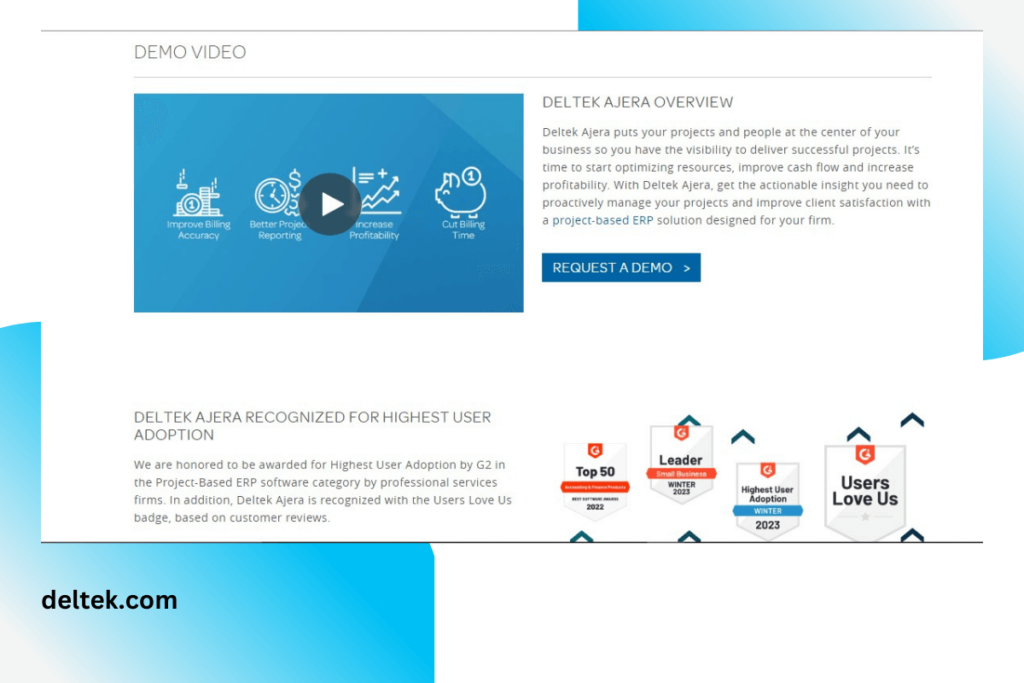
Deltak Ajera is an ERP tool used by architecture and engineering firms.
It is used to help companies enhance their profitability and rate of utilization.
Perfectly assists with the functions of optimizing back-office accounting processes.
It offers AEC professionals efficiency with accounting responsibilities including billing and payroll.
Deltek Ajera is specifically built around architecture and engineering practices, boasting an all-in-one solution.
With functionalities including project management, planning, and Business Intelligence (BI), Deltek Ajera is primarily intended for managing the project lifecycle through invoicing and accounting.
Also, with project management features such as scheduling and real-time overview of projects and tasks, managers and architects can generate automatic reports that can be distributed via the platform.
Ajera is available on different platforms including premise and cloud with CRM functionality as extra and supporting modules.
7. Priority Matrix
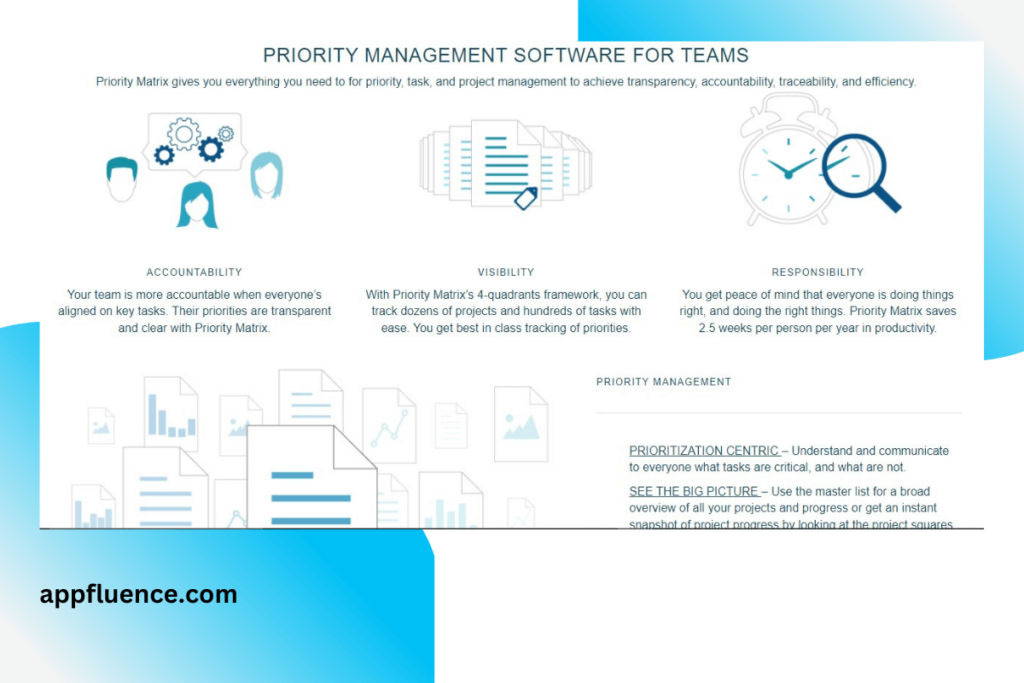
Priority Matrix is simple and user-friendly.
It is a project management tool that can be used to manage resources and track project progress.
Its solution is dedicated to architecture firms, particularly to save the teams hours of work.
It offers visibility on projects and enhances the scheduling and assignments of tasks.
Priority Matrix has basic project management templates that can be used to create reports easily, based on the data in the tool.
8. Monograph
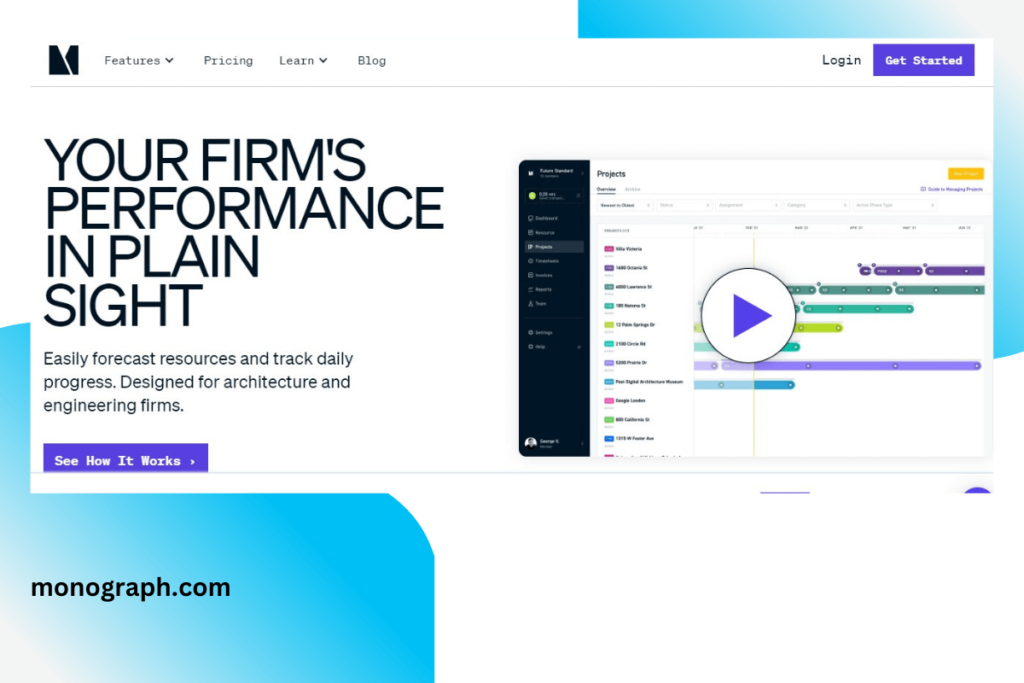
This is a project management software for architects best suitable for small businesses and teams.
It was created by a team of architects and is now widely used by hundreds of firms including Workshop APD and JEMA.
Some of the features are task management, timeline visualizations, budget and accounting management, a Gantt chart, and time tracking.
It is a cloud-based tool purely intended for project management.
As a result, it doesn’t include drafting, modeling, or design features. Monograph boasts exquisite and reliable resource planning as well as forecasting capabilities.
It is therefore acclaimed as “easy-to-use”.
9. Taimer
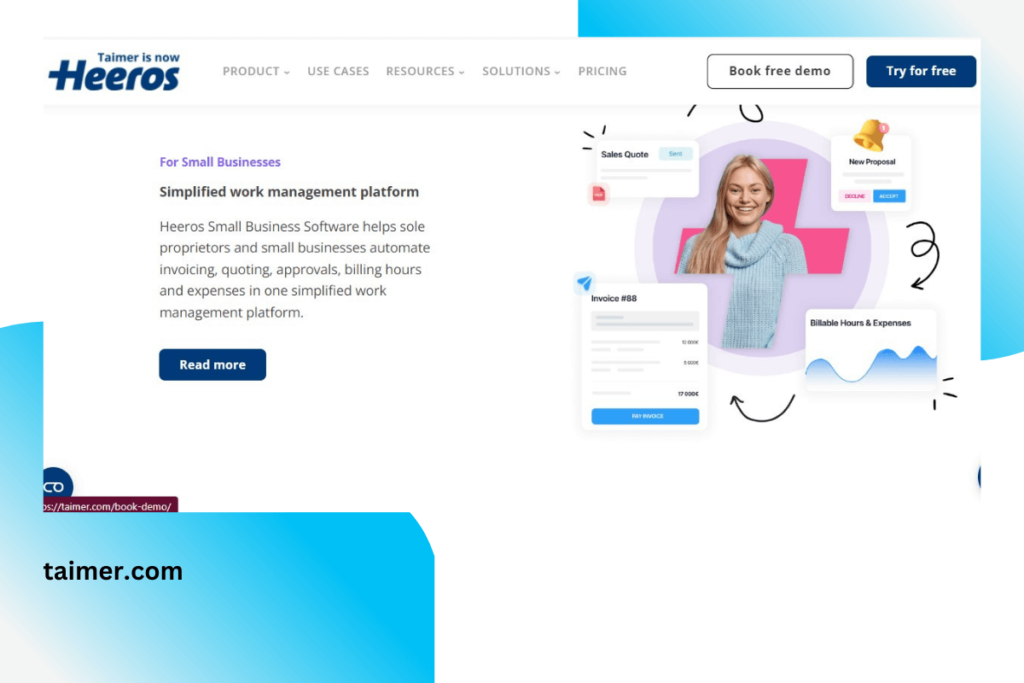
Taimer is another versatile software for architectural project management.
It is mainly intended to be used for CRM capabilities.
Architects and project managers can find a great deal of help with the use of Taimer, especially to estimate and track sales quotes, and ultimately stay on top of their finances.
It has unique capabilities in sales, finance and accounting, BI, and project management.
Thus, it is a great option for keeping all business software and processes in one place.
Architects can use features including resource scheduling and management, document management, and task management.
10. Teamwork

Teamwork is one of the best tools you’ll find on the market for resource management and planning.
It is an agency management system with a Kanban board-style view to track items.
It has triggers that can automate the admin and keep projects moving toward completion.
It is, therefore, great for project planning and team collaboration.
Among the tool’s reporting features are useful for resource planning as you get to see reports on individual tasks and the projects as a whole, which ultimately lends itself to predicting the future resources that would be used for the projects.
The learning curve in Teamwork is steep, and this implies that it could be difficult to locate the particular feature or function that suits your needs.
Also, some of the integrations do not give the exact value that you may seek as a user.
11. TeamGantt
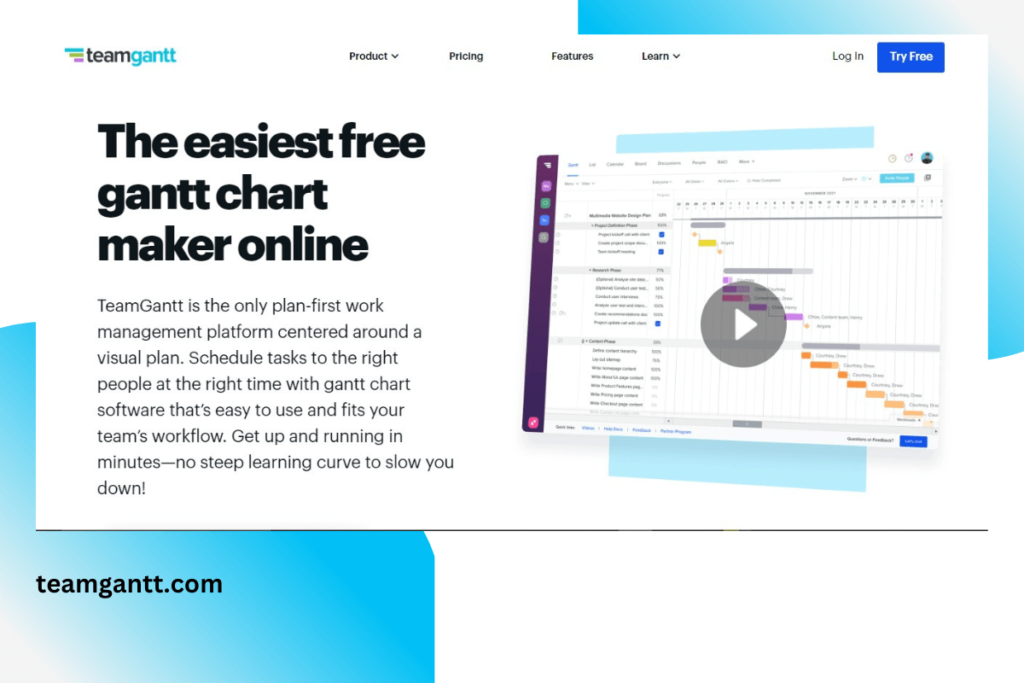
TeamGantt is best for creating and maintaining Gantt charts.
Users can create drag-and-drop Gantt charts and track resources and workloads with the software.
It is a web-based tool with a simple user interface to make Gantt charts easily and in a way that they can be applied to architecture projects.
The drag-and-drop design of the tool makes it very usable, with other features that enhance resource and workload management plus collaboration.
It also gives users the ability to view the workloads available for the team at a glance, adjust the member’s availability, track time, and communicate effectively between the team members.
It is more appropriate for smaller and less complex projects.
This implies that users may experience certain limitations if they intend to use it for more complicated projects with many phases and task dependencies, or in a situation where there are too many team members involved in the project.
12. Monday
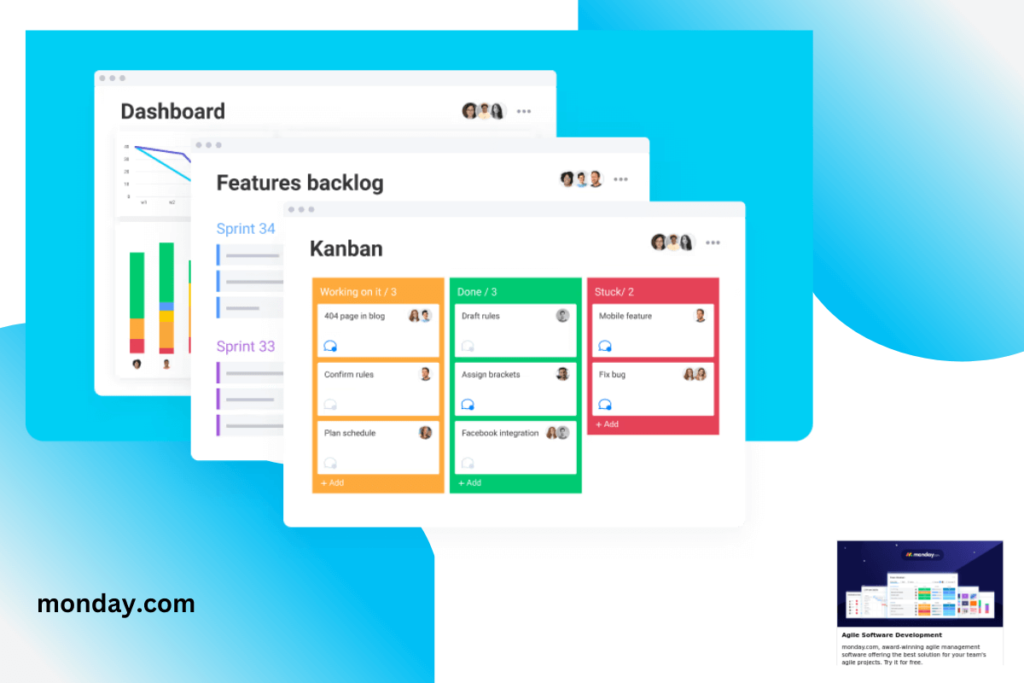
Do you desire a tool with automation capabilities?
Monday is your best shot in this case.
It is an intuitive tool that helps with planning, tracking, and project collaboration.
It has a robust set of options that can automate repetitive and admin tasks, and a user-friendly dashboard where you can track and report data.
It also offers multiple ways to view projects and tasks, as well as a timeline view, Kanban board, and calendar views.
Some of the task management features include setting deadlines for each task and the respective dependencies of the activities.
More so, Monday has file-sharing capabilities. Meanwhile, it misses a few features that architects can use, especially to predict future projects and work, version control, billing and for billing and invoicing.
13. Basecamp
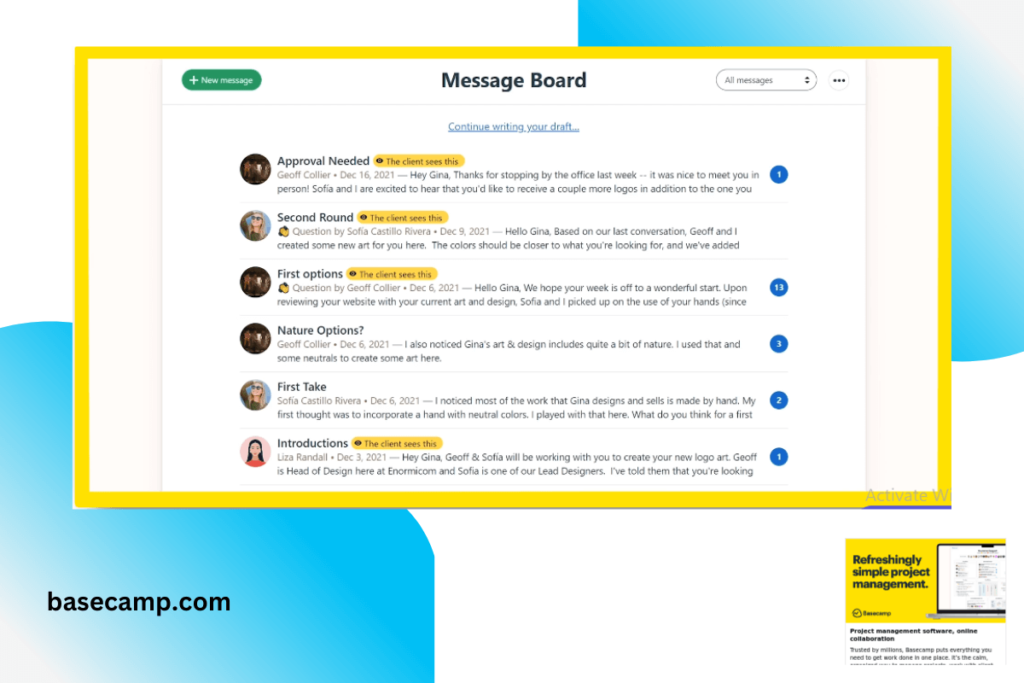
Basecamp is the best tool you can get for team collaboration and communication.
It is a project management and communication tool with features including project boards, file storage, and task check-ins that users can utilize for to-do list creation, communicating with team members, and automating reminders to keep track of and be on top of your architectural projects.
Basecamp has many features and functions including file and document storage, client access options, calendars and schedules, and message boards, to mention a few.
It has some signature hill charts, perfect for visualizing the progress of a project and identifying issues or risks in a project.
It, however, does not include time tracking or billing features- which most architectural firms may require.
Besides, it has limitations in terms of direct integration options, which is obtainable through some third-party tools like Zapier.
14. Asana
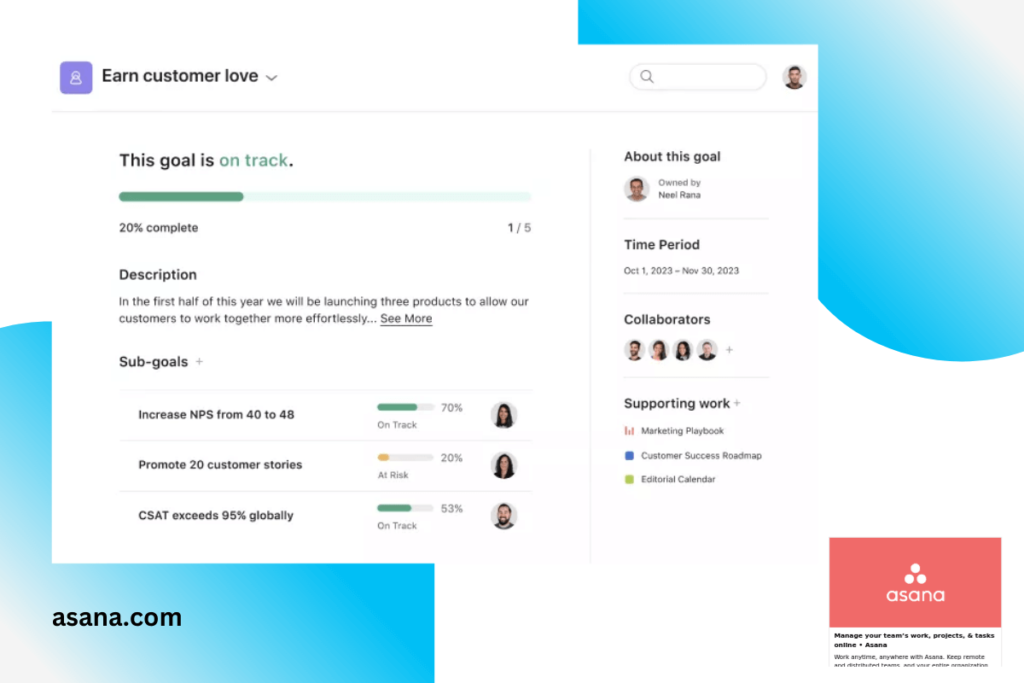
Asana is one of the best tools you can get for visualizing project plans.
On Asana, you can create visual and Kanban-style project plans, as well as keep track of your project portfolio.
It is a project management tool that lead architects use to create visual project plans, especially concerning the degree of complexity of the project.
It has many project management features which are required for monitoring tasks and keeping projects on track.
Some of these features include due dates, approvals dependencies, tasks and subtasks, and project templates.
Asana has a strong portfolio and workload reporting, plus a suite of admin tools for access, security, and team management.
There are also communication and collaboration features that are not overly reliable as users can lose track of communications in the process of planning and executing the project.
15. Notion
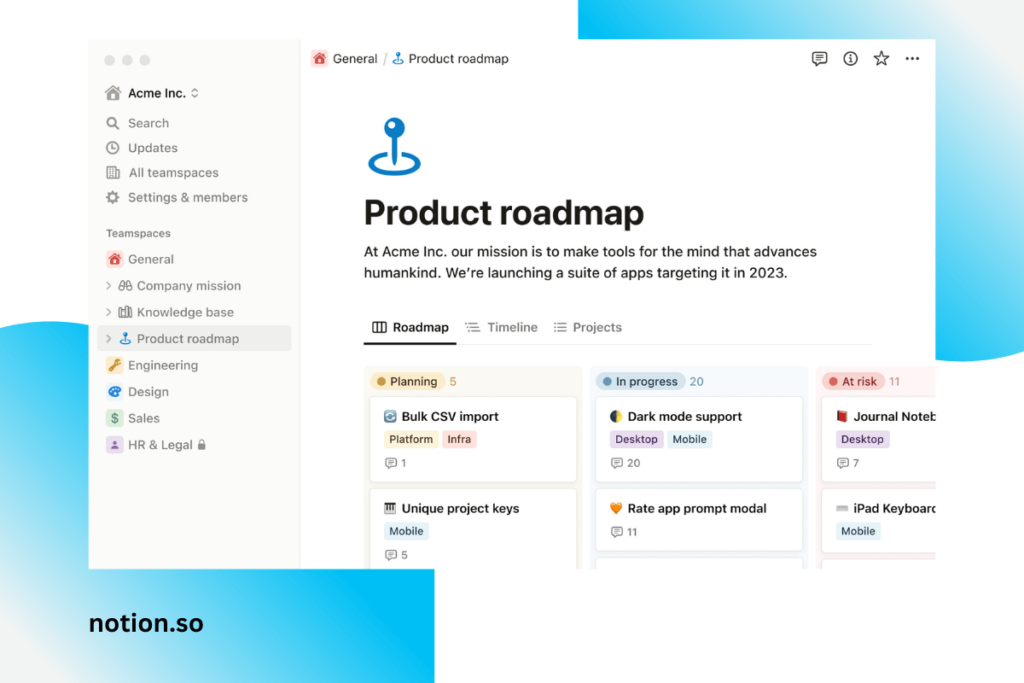
The notion is a workspace app featuring boards, tables, document templates, and lists that can be applied to any architectural project.
It is best for customization options and capabilities such that you can create your to-do lists, company wikis, and Kanban boards.
You can also develop your catalog design assets as you set up projects in such a way that the project becomes easily and effortlessly managed for you and your team.
Meanwhile, as of this writing, Notion lacks some features that architects may find useful such as communication tools, Gantt charts, and reporting and analytics.
But depending on what you want, especially to customize your options, Notion is the best tool for that.
Conclusion
Overall, the software comparison criteria for architectural project management include a user interface, usability, features, and functionality where you look out for design elements, asset storage, collaboration, resource management budgeting and accounting, versioning and document management, and task management, integrations, and value for money.
These tools/software take away the numerous conundrums and unpleasant situations by replacing the traditional excel sheets and ad-hoc planning with the best software available on the market.
In actuality, many of these tools may crossover with those you expect in construction management, especially for the logistics and requirements of construction projects.
Nonetheless, they have features that are specifically suited for architectural project management to help streamline workflow, projects, and processes for architects.
RELATED: Project Management Systems Best For Microsoft Teams | Project File Transfer Management Software | Best Linux Project Management Tools
